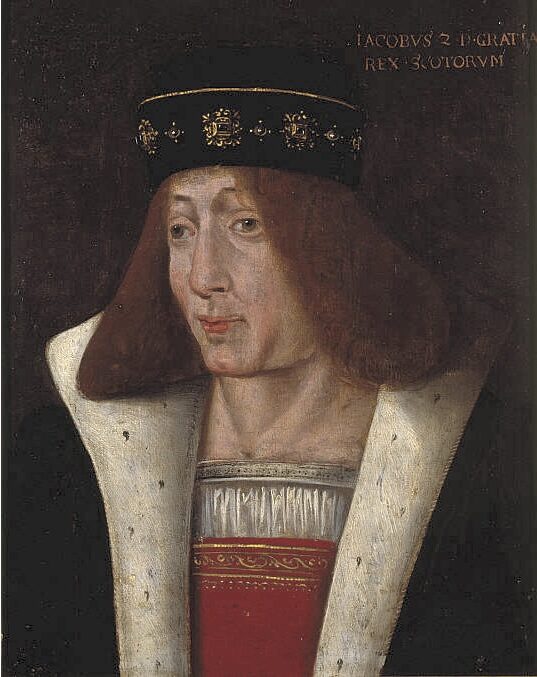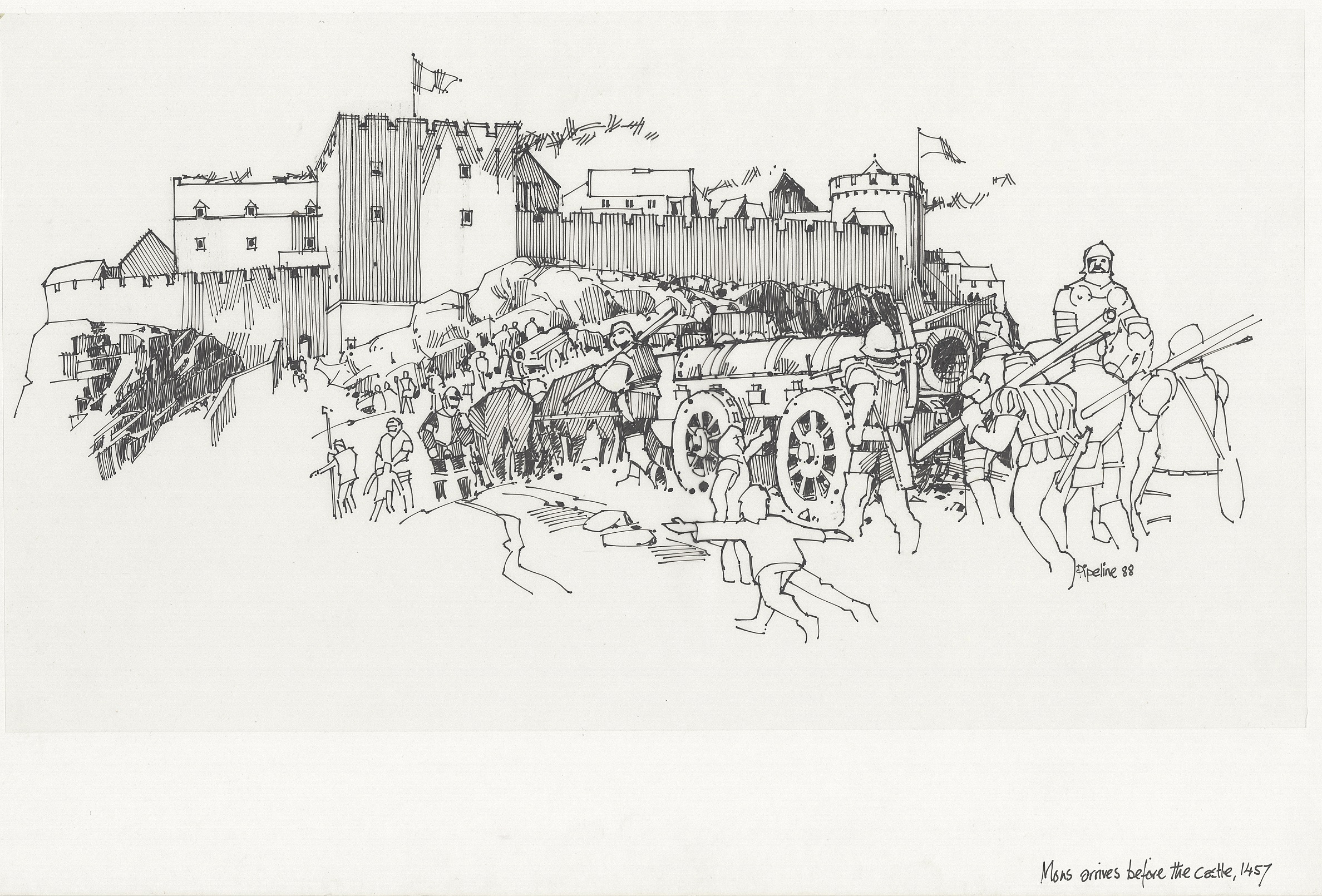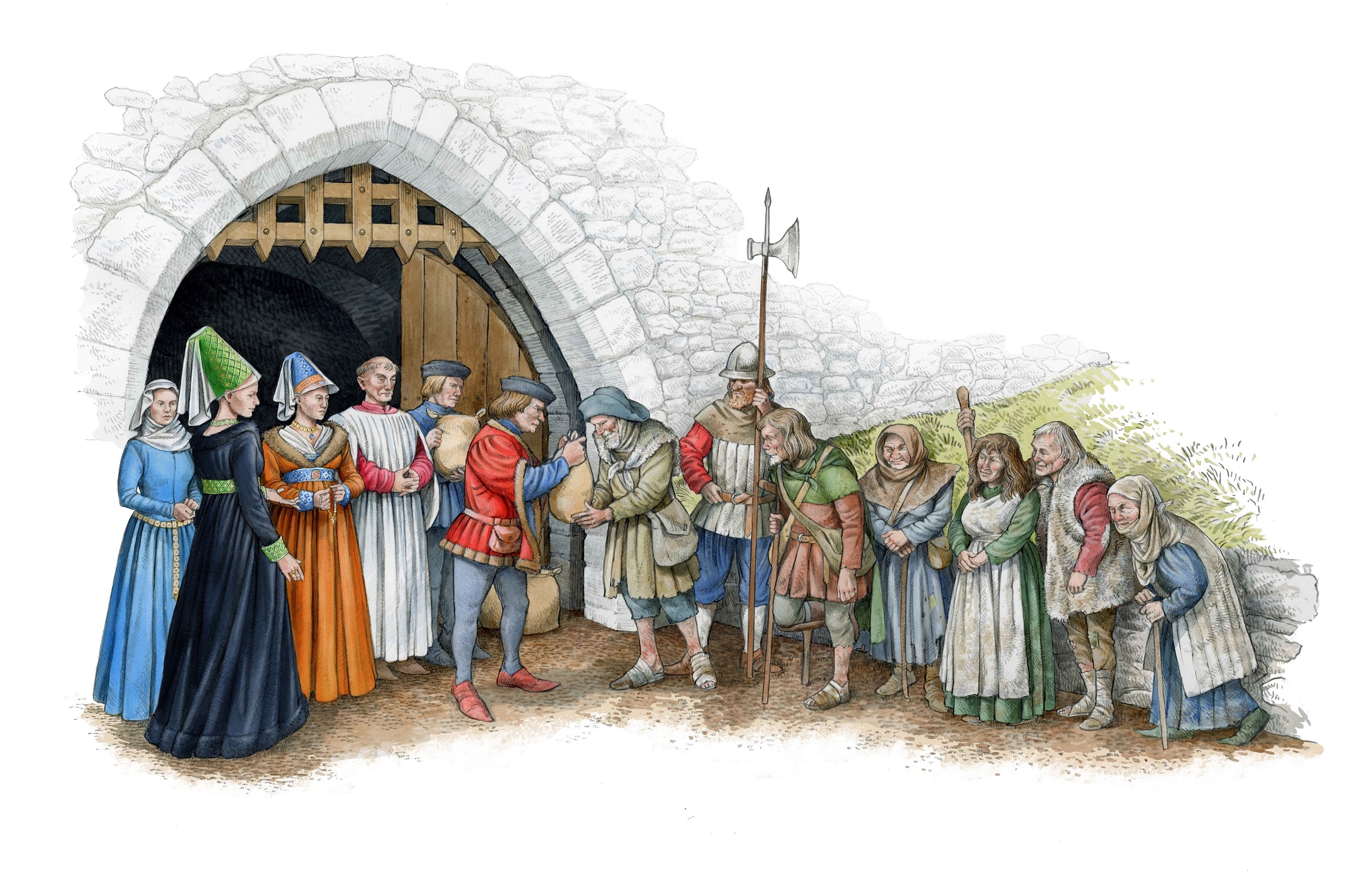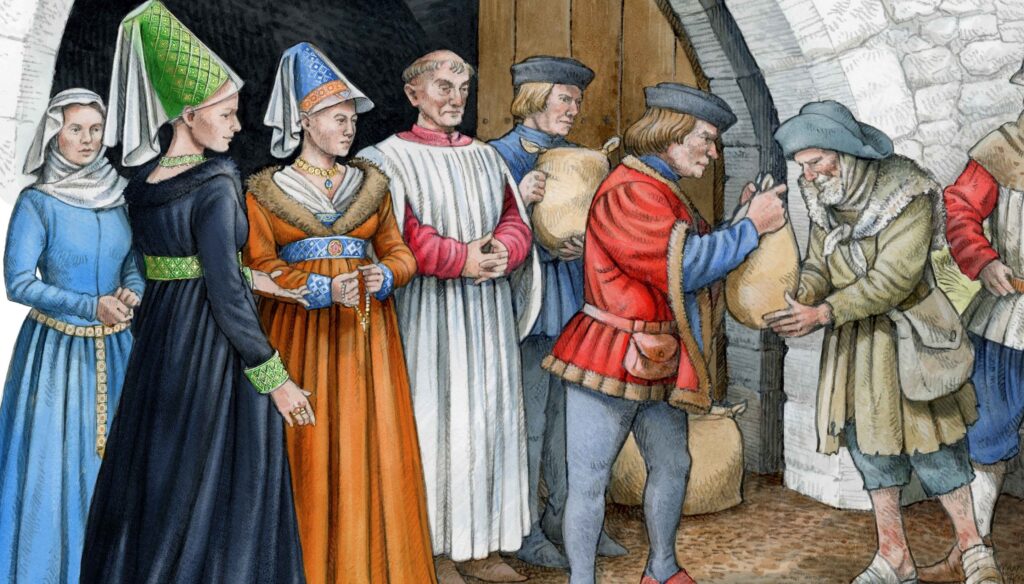In 1449 Mary of Guelders arrived in Scotland with a convoy of fourteen ships. She had travelled from Bruges, part of the territories of her great-uncle, the Duke of Burgundy.
At around 16 years old, Mary was here to marry the 18-year-old James II, King of Scots. A prestigious international alliance had been arranged between Scotland, Burgundy, Brittany, and Guelders, including Mary’s great-uncle as well as her parents, the Duke and Duchess of Guelders.

James II went on to marry Mary of Guelders
The Treaty of Brussels not only provided James with a generous dowry of 60,000 crowns, around £20,000 Scots, but an impressive array of weapons which filled five of the fourteen ships. It included armour, shields, longbows and crossbows, swords, staff weapons, and guns. The Duke of Burgundy sent the famous bombard Mons Meg, along with another bombard, later, in 1457.

Mons Meg arrives at Edinburgh Castle, AD 1457.
A Life of Luxury
A lavish marriage ceremony took place at Holyrood Abbey on 3 July 1449 and Mary was crowned queen, dressed in a violet gown with ermine fur. Afterwards, guests attended a great banquet at which the wine was said to be as plentiful as seawater.
As part of her vast dower lands, Mary was to be granted properties including Linlithgow Palace, Doune Castle, and Stirling Castle. These were to become her property only if and when she outlived her husband.
As Queen of Scots, Mary did her duty by giving birth to eight children. Her first child, a daughter, was born prematurely at Stirling in 1450 and died soon afterwards:
The yere of God IM iiijC & L þe xix day of maij qwene mary partit with barne in striuling xij oulkis [12 weeks] befor hir tyme and the barne liffit bot the space of sex houris.
Another child, a son, also died in infancy. Mary experienced further loss on 3 August 1460, when James was killed while besieging Roxburgh Castle. Mary immediately organised the coronation of her eldest son, now James III, at Kelso Abbey. Her men succeeded in taking Roxburgh.
As dowager queen, Mary governed the kingdom on behalf of the eight-year-old king. She was not without her critics, who “said that thai war litill gud worth bath spirituale & temporall That gaf the keping of the kinrik [kingdom] till a woman”. Despite this, she was the de facto ruler of Scotland.
Charity to the People of Stirling
Although she lived a life of power, wealth and luxury, Mary was a pious and charitable woman. One of her many acts of generosity was the support of six poor people who lived outside Stirling Castle, one of her dower properties.
to the six paupers living near the gate of the castle of Stirling, from 24 March to 01 August [1461], receiving daily, by the order of the mistress, the queen, six pence, £4 4s. 6d. And for nineteen loads of coal given to the said paupers, that is, one load every week, by the said order and for the same period, 9s. 6 d.
to the six paupers living near the gate of the castle of Stirling, by the order of the mistress, the queen, from 05 February 1461 to 07 September next, three chalders of grain.
for the same six paupers living near the gate of the castle of Stirling, from 01 August 1462 to 08 August 1463, that is, the day of this account, … each to receive a penny every day, £9 3s. 6d. And for sixty-five loads of coal given to the same paupers over the same period, … 36s. 6d.
The identities of these poor people are unknown, but without this charity, their situation would have been precarious. It’s possible that disability, illness or old age prevented them from earning money through work.

The Challenges of Poverty
Laws enacted by the Scottish parliament suggest that poverty was a significant issue. In 1425 it ordained that people aged between fourteen and seventy years of age were not allowed to beg unless they had no other way to make a living. Those allowed to beg would be given a token as proof, and people begging without a token might be burned on the cheek or banished:
it is ordanyt that na thigar be thollyt to thyg nor bege nothir in burghe nor to lande betuix xiiij and iij score [and ten] of yheris of age bot thai be seyne be the consall of the toune or of the cuntre at thai may nocht vyne thar leyffing othir vays. And thai that sa beis fundin sall have a takin to land of the schera and in bwrowis off the aldirmen and baylyheis, and that undir the payn of birnynge on the cheyk and bannyssing of the cuntre.
This law was repeated in 1458, suggesting that unauthorised begging was still taking place.
As well as begging, poor people might turn for help to hospitals: institutions founded to provide accommodation, food, clothing, and care for the poor and sick. The survival of such medieval hospitals is poor. But at one example, the Maison Dieu in Brechin, visitors can still see the remains of the chapel.
Mary of Guelders’ Hospital on the Castle Hill
Mary founded her own hospital on the Castle Hill of Stirling. Financial records from 1461 show that she paid for the upkeep of six canons and provided them with coal. She also provided “the paupers in the hospital on the Castle Hill” with grain.
It seems likely that the paupers living near the gate of Stirling Castle were the same as those residing in the queen’s hospital on the Castle Hill. They would have lived alongside the six canons: churchmen whose responsibility it would have been to pray for the soul of the founder. It’s unclear when Mary’s charity to these people began. Her own financial records only survive from the time of her widowhood onwards.

A drawing of Stirling Castle in the late 17th century by John Slezer
Another of Mary’s foundations was Trinity College Kirk and Hospital in Edinburgh, established in 1462. The church was created to honour the Holy Trinity, where churchmen would pray for Mary and her family, and to be her final resting place, while the hospital was to house and maintain thirteen poor people.
Mary’s generosity towards the six poor people living outside Stirling Castle fit into a wider pattern of charity and piety. It characterised her time as dowager queen. She died, aged only around thirty, on 1 December 1463 and was buried in Trinity College Kirk.
The tradition of including Stirling Castle in the dowers of queens consort continued, and the castle was granted in turn to Margaret of Denmark, Margaret Tudor, and Mary of Guise.
Explore Further
There are more stories like this from Stirling Castle on our blog. Or venture on your own journey through history with a visit to Stirling Castle! Stirling Castle holds countless stories for you to uncover.

